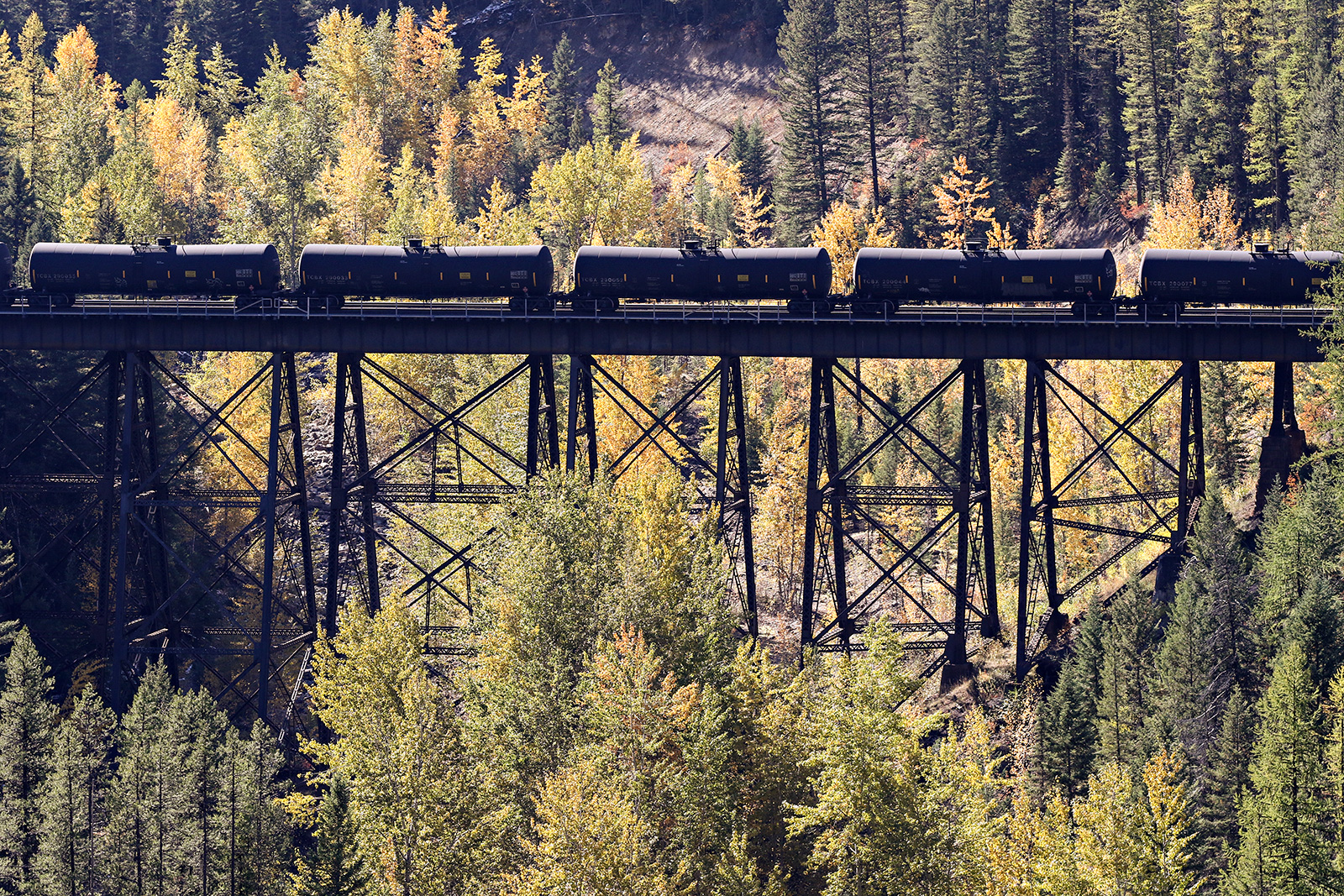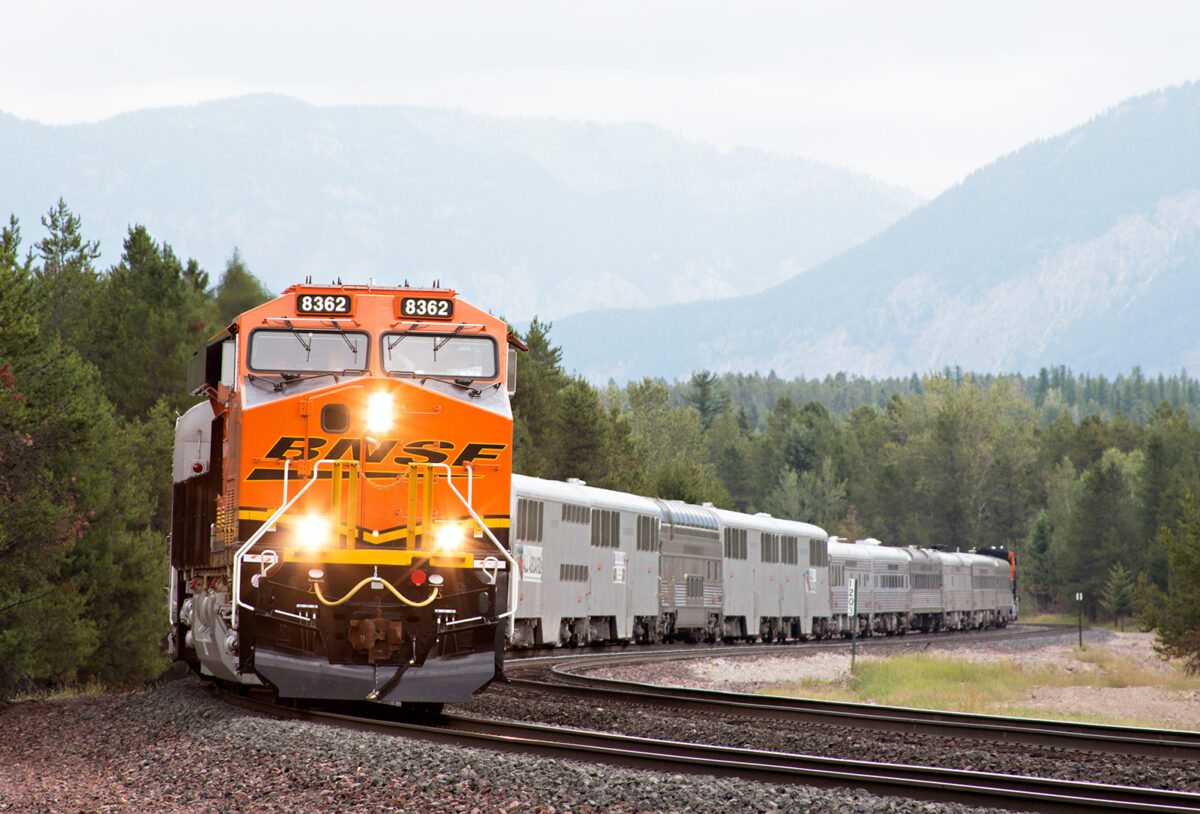Conservation Groups File Intent to Sue Railway Over Grizzly Deaths
Three grizzly bear mortalities occurred last month on BNSF Railway tracks near Glacier National Park, where the company continues to operate without an incidental take permit for the endangered species
By Tristan Scott
Wildlife advocacy groups have threatened to sue BNSF Railway Company for its role in train collisions that last month killed three grizzly bears near Glacier National Park, where the railroad giant continues to run dozens of freight trains each day despite lacking a federal permit authorizing the incidental “take” of the federally protected species.
The most recent deaths, first reported by the Beacon on Oct. 4, occurred on a segment of the railroad that operates in the heart of the Northern Continental Divide Ecosystem (NCDE), which is home to the largest population of grizzly bears in the Lower 48. According to data, 64 grizzly bears have died from train strikes on BNSF tracks since 1980.
The 2023 population estimate for grizzly bears in the NCDE is 1,163 bears.
Reports on the spate of recent deaths prompted the Western Environmental Law Center, which is representing WildEarth Guardians and the Western Watersheds Project, to send BNSF a notice of its intent to sue. The company in turn has 60 days to answer the notice.

For decades, the freight trains traveling over Marias Pass toward Glacier National Park and the Great Bear Wilderness along a 206-mile stretch of tracks between Shelby and Trego have posed a threat to the grizzlies living there, particularly when a derailment causes a grain spill, or a train-killed deer or livestock carcass draws the bears onto the busy tracks. Since 2004, a host of state, federal and tribal wildlife management agencies, as well as non-governmental organizations and conservation groups, have worked with the railroad to mitigate the hazards to threatened and endangered species like grizzlies, with varying degrees of effectiveness.
Three years ago, BNSF Railway Company proposed the most comprehensive solution yet when it applied to the U.S. Fish and Wildlife Service (FWS) for an Incidental Take Permit (ITP) and formally submitted a Habitat Conservation Plan (HCP) outlining measures it would take to reduce train-caused grizzly mortalities in the region. The HCP committed more than $2 million to fund the salaries and operational costs of two new Montana Fish, Wildlife and Parks (FWP) grizzly bear technicians and a third grizzly bear technician for the Blackfeet Nation, as well as related grizzly bear conservation projects and programs, including waste management, electric fencing, remote cameras, radio collars, hunter education, and a new grizzly bear database over the seven-year life of the plan.
Under the plan, BNSF would also establish a reserve account of $1 million to fund programs and projects designed by the HCP technical committee to respond to new data discoveries, the identification of new factors contributing to train strikes, “or the arrival of new challenges and solutions as grizzly bear populations expand.” Developed over the course of nearly 20 years and based on extensive consultation with bear experts from FWS, FWP, the Blackfeet Nation and Glacier National Park, the plan and the pot of BNSF money would be administered by the Montana Outdoor Legacy Foundation, a nonprofit organization that works closely with FWP on conservation efforts throughout the state.
In exchange, FWS would issue BNSF an ITP under Section 10 of the Endangered Species Act (ESA), an exception that allows the federal wildlife management agency to issue permits for the “incidental take” of grizzly bears “if such taking is incidental to, and not the purpose of, the carrying out of an otherwise lawful activity.”
If issued, the permit would authorize the take of approximately 18 grizzly bears incidental to BNSF Railway operations during a seven-year period on the stretch of railway between Shelby and Trego.

With the recent spate of train-killed grizzlies in September, including a third grizzly mortality last month on BNSF tracks east of the Continental Divide on the Blackfeet Indian Reservation near Meriwether, state, federal and tribal wildlife managers are confused by the postponement of both the plan and the incidental take permit, which is a legal requirement under the ESA.
According to FWS, it’s been waiting on BNSF Railway to finalize the habitat conservation plan since the closing of a public comment period in early 2021, when the federal agency announced an incidental take permit application and associated habitat conservation plan from BNSF. Since the closing of the public comment period, BNSF has been working to finalize the habitat conservation plan.
“Once an applicant finalizes and submits a final habitat conservation plan, the Service will review and complete decision documents, including a biological opinion and a determination as to whether or not the application meets criteria for issuing an incidental take permit,” according to a prepared statement from Joe Szuszwalak of FWS. “In the interim, BNSF Railway continues to voluntarily implement minimization measures along the railway, including cleaning and clearing attractants.”
Asked about the recent grizzly bear deaths, as well as historic mortalities that have occurred without an incidental take permit, Szuszwalak said “the Service is aware and engaged in discussions with BNSF Railway to address this issue.”
According to an Oct. 6 email from a BNSF spokesperson, the company and FWS “have been working collaboratively to respond to and address public comments and to consider and incorporate data and information published by FWS and the NCDE Grizzly Bear Monitoring Team after the original BNSF application was submitted.”
“This process, while comprehensive, has taken considerable time to accomplish. BNSF expects that Service will be able to consider a final version of the HCP before the end of 2023. BNSF has never sought to delay the final HCP for any reason, including the possible delisting of the grizzly bear. Delisting was discussed in the Draft HCP published in 2021, so this is not a new topic.”

Both current and former wildlife managers the Beacon interviewed said BNSF has gone to great lengths through the years to clean up bear attractants from its railway, and they commended BNSF employees for their response when a train strike does occur. However, they also speculated that the ongoing delays by the company to formalize its application for an incidental take permit, as well as to distribute mitigation funds to state and tribal wildlife agencies, are calculated.
In February, FWS announced it is considering whether grizzly bears in the NCDE are sufficiently recovered to trigger removal from protections under the Endangered Species Act, in which case BNSF wouldn’t need a take permit.
“I have essentially been involved in this thing for 20 years and my opinion is that BNSF is stalling until bears get delisted, in which case they wouldn’t need an incidental take permit,” Tim Manley, a retired grizzly bear biologist who spent 37 years as Montana Fish, Wildlife and Parks’ grizzly bear management specialist in northwest Montana, said. “In 2021, the final draft was put together and sent out for public comment. It still has not been signed off on by BNSF and here we’re going on three years.”
Pete Frost, an attorney with the Western Environmental Law Center who filed the supplemental notice of intent to sue BNSF, also threatened to sue the railway company in 2019 after nine bears were reportedly killed due to train strikes in the NCDE. However, the coalition of wildlife advocacy groups eventually backed away from the lawsuit, in part because Frost says the burden to prove the “prospect of future take” was too high. Frost said he hadn’t heard of any other grizzly bear mortalities on BNSF tracks until reading the Beacon’s Oct. 4 report.
“To succeed in a lawsuit, you have to prove there’s a prospect of future take, and we thought it would be difficult to do so because we didn’t have any other reports of grizzly bear deaths. Until now.”
BNSF said it is aware of the three grizzly bear mortalities in 2023 on the railroad right-of-way and reported those deaths itself “consistent with its long-standing commitment to do so (a commitment that is memorialized in the HCP).”
“BNSF is not aware of any evidence that these bears were drawn to the right-of-way by spilled grain, carrion, or vegetation on land controlled by BNSF. BNSF notes that in many years (most recently in 2020 and 2021) no grizzly bears were killed in the right-of-way,” a company spokesperson wrote.
“BNSF will continue its work – in partnership with federal, state and tribal agencies – to minimize grizzly bear strikes in its right-of-way while the HCP is pending,” the spokesperson wrote. “BNSF remains fully committed to the proposed HCP and we look forward to expanding our grizzly bear conservation partnerships when the HCP is approved.”
Editor’s note: This story has been updated to include a response from BNSF.